

There is a range of practices that aim to keep disease out of your property. This checklist summarises the actions you can take to protect your pigs and to minimise the spread of more common diseases.
Assess your property against each section to ensure your checklist is adequate.
Healthy pigs
Healthy pigs are intelligent, social, alert animals. They forage in the ground for food, and eat and sleep frequently throughout the day.
The normal Heart rate is 70–120 beats per minute, Breathing rate is 10–20 breaths per minute and the normal temperature is 38.5-39.5°C
Sick pigs may lose their appetite, separate from other pigs, become listless, have a swollen navel, udder or joints, have rapid or irregular breathing, sneeze. Sick pigs will also persistently cough or pant, shiver, have discoloured or blistered skin, lose body condition, may become lame and lose co-ordination.
Managing pig health
To ensure Pig health, Inspect your pigs at least once a day.
Separate sick pigs from healthy animals.
Always consult a vet about any unusual illness or unexpected deaths.
Vaccinate for common diseases.
Keep a record of veterinary treatments.
Provide access to weatherproof shelter.
If kept in paddocks, rotate your pigs onto fresh pasture (before 60% grazed).
Regularly clean pig pens and/or remove manure from paddocks.
Train staff to follow biosecurity practices for disease prevention and identification.
Moving pigs onto/off your property
Check the health of your pigs before transporting them off the property.
Keep records of pig movements onto and off your property
Identify your pigs with an pig ear tag (any size pigs) or your pig brand tattoo (pigs over 25kg).
If you bred the pig, use a yellow tag in their left ear, or tattoo their left shoulder.
If you did not breed the pig, use an orange tag in the pig’s right ear or tattoo their right shoulder.
Clean and disinfect vehicles/equipment before leaving/returning to your property.
Clean all clothing before leaving and returning to the property.
 Contact Jaguza Support
Contact Jaguza Support